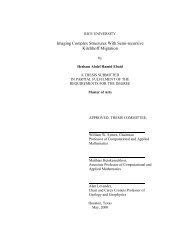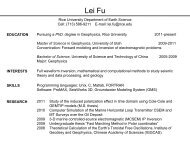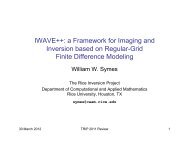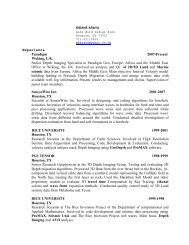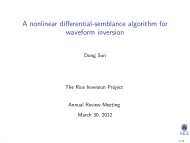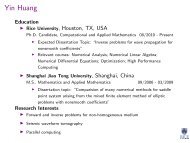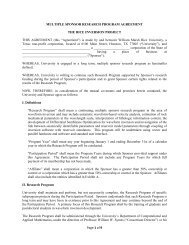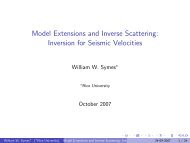Velocity Analysis and Waveform Inversion - The Rice Inversion Project
Velocity Analysis and Waveform Inversion - The Rice Inversion Project
Velocity Analysis and Waveform Inversion - The Rice Inversion Project
Create successful ePaper yourself
Turn your PDF publications into a flip-book with our unique Google optimized e-Paper software.
<strong>Velocity</strong> <strong>Analysis</strong> <strong>and</strong> <strong>Waveform</strong> <strong>Inversion</strong>William W. Symes<strong>The</strong> <strong>Rice</strong> <strong>Inversion</strong> <strong>Project</strong>
AgendaOverviewDifferential Semblance VAImage Volumes: Kirchhoff vs. Wave EquationDifferential Semblance MVAEffective <strong>Waveform</strong> <strong>Inversion</strong> = Nonlinear MVAChallengesConclusions
How to access this short course online:TRIP web site: www.trip.caam.rice.edugo to downloadable materials link, grab (these) slides <strong>and</strong> referencelist from short course on migration velocity analysis <strong>and</strong> waveforminversion
<strong>Velocity</strong> <strong>Analysis</strong> vs. <strong>Waveform</strong> <strong>Inversion</strong>(Migration) velocity analysis (“MVA”): update velocity parametersto satisfy semblance condition in migrated image volume (usually:flat gathers)◮ visual/interactive techniques, from 60’s on◮ often converted to traveltime inversion (reflection tomographyin data, migrated domains) via automated picking ⇒optimization of traveltime misfit◮ backproject traveltime residuals<strong>Waveform</strong> inversion (“WI”): update model parameters to matchpredicted to observed data (parameters include p-wave velocity,but maybe much more)◮ optimization of waveform misfit directly, without intermediatereduction to traveltime◮ backproject waveform residuals
<strong>Velocity</strong> <strong>Analysis</strong> vs. <strong>Waveform</strong> <strong>Inversion</strong>Bottom line: today,◮ MVA integrated into industrial processing◮ WI still academic - intrinsic obstaclesAgenda for this course:◮ how to formulate MVA as a waveform-based optimization(update velocity by backpropagating waveform residuals)◮ MVA = WI based on Born approximation◮ proposal: reformulation of WI based on MVA ideas
AgendaOverviewDifferential Semblance VAImage Volumes: Kirchhoff vs. Wave EquationDifferential Semblance MVAEffective <strong>Waveform</strong> <strong>Inversion</strong> = Nonlinear MVAChallengesConclusions
Measuring SemblanceFoundation (“semblance”) principle of velocity analysis: adjustvelocity to obtain internally consistent image volumesExample: simplest imaging algorithm = NMO/stack.Image volume = NMO-corrected CMPsInternal consistency = flat events
Measuring Semblancetime (s)00.51.01.52.0offset (km)0.5 1.0 1.5Example:◮ CMP from North Sea 2D survey(NAM, courtesy Shell Intl.Research).◮ Predictive decon, low pass filter,mute◮ Flat lying sediments to 3s+ ⇒convolutional model plausible.
Measuring Semblance0offset (km)0.5 1.0 1.50offset (km)0.5 1.0 1.50offset (km)0.5 1.0 1.50.50.50.5time (s)1.0time (s)1.0time (s)1.01.51.51.52.02.02.0NMO corrected: velocity slightly low, about right, slightly high.
Measuring SemblanceIdea of differential semblance: if velocity is wrong,◮ far traces are uncorrelated, but◮ correlation of near traces indicates velocity errorEarliest known references: J. Castagna 1986 (inaccessible - cited inSarkar et al. 2001), S. 1986. Related ideas (“plane wave PEFs”) -Claerbout, 80’s <strong>and</strong> 90’s (IEI, Fomel 2002).
A Differential Semblance MethodKinematic quantities:Interval velocity v(t 0 , x, y) - depends on midpoint (x, y) <strong>and</strong>zero-offset two-way time t 0 (proxy for depth z).Suppress x, y from notation, for simplicity - consider one midpoint.Square RMS slowness u(t 0 ) = t 0 R t00 v 2 .Hyperbolic √2-way traveltime approximationT (t 0 , h) = t0 2 + 4u(t 0)h 2 . (h=half-offset).Inverse TT function T 0 (t, h) - satisfies T 0 (T (t 0 , h), h) = t 0 . ”t 0for which 2-way time at offset h is t.”
A Differential Semblance MethodData CMP at midpoint with coords x, y, offset h = d(t, h).NMO-corrected dataI (t 0 , h) = d(T (t 0 , h), h),Offset divided difference operatorD h I (t 0 , h) = I (t 0, h + ∆h) − I (t 0 , h).∆h
A Differential Semblance MethodDifferential semblance function:J[v, d] = 1 2∑h0∫ tmaxdt|D h I (T 0 (t, h), h)| 2 ,Algorithm:◮ NMO-correct each midpoint gather: I (t 0 , h) = d(T (t 0 , h), h);◮ form offset derivative (divided difference) D h I (t 0 , h);◮ inverse NMO-correct: I (T 0 (t, h), h);◮ square <strong>and</strong> sum over t 0 <strong>and</strong> h (<strong>and</strong> over midpoints x, y).
A Differential Semblance Method3.02.5<strong>Velocity</strong> (km/s)2.01.51.00 0.5 1.0 1.5 2.0Depth (km)Two interval velocities: reference/initial (green) <strong>and</strong> estimate(blue).
A Differential Semblance Method0offset (km)0.5 1.0 1.50offset (km)0.5 1.0 1.50offset (km)0.5 1.0 1.50.50.50.5time (s)1.0time (s)1.0time (s)1.01.51.51.52.02.02.0I (t 0 , h) = NMO corrected sections. Left = 20% ref, 80% est;Center = 100% est; Right: -20% ref, 120% est.
A Differential Semblance Method0offset (km)0.5 1.0 1.50offset (km)0.5 1.0 1.50offset (km)0.5 1.0 1.50.50.50.5time (s)1.0time (s)1.0time (s)1.01.51.51.52.02.02.0D h I (t 0 , h) = offset divided differences = scaled differences ofneighboring traces.
A Differential Semblance Method0offset (km)0.5 1.0 1.50offset (km)0.5 1.0 1.50offset (km)0.5 1.0 1.50.50.50.5time (s)1.0time (s)1.0time (s)1.01.51.51.52.02.02.0D h I (T 0 (t, h), h) = inverse NMO applied to offset divideddifferences. Mean square = DS objective function.
A Differential Semblance Method1.00.8Differential Semblance0.60.40.200 0.5 1.0 1.5 2.0Relative <strong>Velocity</strong> PerturbationDS = mean square of D h I , as function of relative velocity pert r:velocity = (1 − r)∗ref + r∗est.
A Differential Semblance MethodAutomated via NMO-based differential semblance: given CMPdata d <strong>and</strong> initial guess v 0 , find v to minimize J[v, d] usingnumerical optimization.DS is smooth <strong>and</strong> (apparently) unimodal ⇒ gradient-basedmethods will work, find global min!Gradient-based optimization algorithm: described in Li & S. 2007.Central issue: computation of gradient ∇ v J[v, d].Combine gradient with quasi-Newton optimization algorithm(”LBFGS”).[demos using NAM data - 1, 2, 3]
A Differential Semblance MethodSome questions, within the realm of weak lateral heterogeneity:◮ What about other possible objective functions?◮ What theoretical support exists?◮ What about multiples <strong>and</strong> other coherent noise?
Total Stack PowerAn alternative: total stack powerJ TSP (d, v) =∫ tmax0dt 0 ( ∑ hI (t 0 , h)) 2Reaches MAX when v is kinematically correct - then summation ofNMO-corrected data along offset axis interferes constructively.See Toldi 1989, Fowler 1986, Shen et al. 2005, Soubaras <strong>and</strong>Gratacos 2007.
Total Stack PowerRelation with semblance:Recall semblance: simplest (unscaled) definition isS[t 0 , v RMS ] = ( ∑ hI (t 0 , h)) 2(i.e. a ”square of sum” rather than ”sum of squares”).NMO correction d → I performed with constant RMS velocityv RMS - since I (t 0 , h) depends only on v RMS (t 0 ), can be doneeconomically.Set V RMS [v] = RMS velocity from interval velocity v. <strong>The</strong>nJ TSP [v, d] =∫ tmax0dt 0 S[t 0 , V RMS [v](t 0 )].
Total Stack PowerRMS velocity (km/s)1.5 2.0 2.5 3.01.0ZO time (s)1.52.02.53.0J TSP [v, d] = sum of semblance S along t 0 , V RMS [v](t 0 ) trajectory.
Total Stack Power1.01.00.80.8Stack Power0.60.4Differential Semblance0.60.40.20.200 0.5 1.0 1.5 2.0Relative <strong>Velocity</strong> Perturbation00 0.5 1.0 1.5 2.0Relative <strong>Velocity</strong> PerturbationComparison: Total Stack Power (left), Differential Semblance(right), sampled along line segment in interval velocity space.
Total Stack Power1.000.0080.95Stack Power0.0060.004Differential Semblance0.900.850.800.0020.7500 0.02 0.04 0.06 0.08 0.10Relative <strong>Velocity</strong> Perturbation0.700 0.02 0.04 0.06 0.08 0.10Relative <strong>Velocity</strong> PerturbationDetail at left side of previous figures.
Total Stack PowerSummary of accumulated evidence re TSP:◮ TSP objective strongly peaked at optimum velocity choice,relatively flat elsewhere.◮ TSP prone to local minima at grossly incorrect velocities: seeChauris <strong>and</strong> Noble 2001 for “proof” that this is intrinsicproperty of TSP objective.◮ Chief consequence: gradient methods to optimize TSP requiregood initial guess of velocity - <strong>and</strong> it’s hard to say a prioriexactly how good, or whether any particular velocity is goodenough!◮ However: peak shape <strong>and</strong> location insensitive to coherentnoise for near-correct velocities, so robust in that sense.
<strong>The</strong>ory for DS-NMO<strong>The</strong>orem: J is smooth as function of velocity parameters. For datawith sufficiently high S/N, all stationary points of J areapproximate global minima (S., 1999, 2001).◮ Loose translation: no local mins.◮ S/N refers to fidelity to the convolutional model - best RMSapproximation by forward convolutional modeling (relation toleast squares data fitting!).◮ Stationary points approximate global minima in sense ofhigh-frequency asymptotics - direct link between b<strong>and</strong>width<strong>and</strong> velocity resolution.◮ Numerical experience as predicted by <strong>The</strong>orem.
<strong>The</strong>ory for DS-NMOA step in the proof, of independent interest: assuming sufficientoffset sampling,soD h I (t 0 , h) = D h d(T (t 0 , h), h)≃ ∂d∂t (T (t 0, h), h) ∂T∂h (t 0, h) + ∂d∂h (T (t 0, h), h)D h I (T 0 (t, h), h) =(P ∂d∂t + ∂d )(t, h),∂hin which P(t, h) = ∂T∂h (T 0(t, h), h) is the offset ray parameter.
<strong>The</strong>ory for DS-NMOAssume d is convolutional model data for an target velocity v ∗ , forconvenience with δ(t) wavelet. That is,Easy calculus exercise:d(t, h) = r(T ∗ 0 (t, h)).∂T ∗ 0∂h = −P∗ ,the offset ray parameter for the target velocity. Thus(D h I (T 0 (t, h), h) ≃ (P − P ∗ ) ∂d )(t, h).∂t
<strong>The</strong>ory for DS-NMOUpshotJ[v, d] = 1 2≃ 1 2∑h∑h∫ tmax0∫ tmax0dtdt|D h I (T 0 (t, h), h)| 2 ,((P − P ∗ ) ∂d∂t (t, h) ) 2,which leads to a tomographic interpretation of DS: objective isdata-weighted error in offset ray parameter.⇒ connection to stereotomography - Chauris & Noble 2001.
Coherent NoiseDS is tomographic ⇔ detects moveout ⇒ moveout ambiguity(coherent noise, eg. multiples) must degrade velocity estimate.Example: NAM data shown previously consists mostly of multiples- they are nicely flattened, but lead to absurdly slow velocity below2 s.Li & S. 2007: Study based on Mobil “AVO” (Viking Graben) data,Keys & Foster 1998.Upshot:◮ DS finds weighted average of apparent moveout velocities(least squares!);◮ if moveout dichotomy exists, can use in conjunction with dipfilter to remove noise, enhance velocity estimation.
Coherent NoiseCMP Number800 1100 1400 170001Time (s)23Four CMPs from middle part of Mobil AVO line: hyperbolic Radondemultiple, low-pass filter, mute.
Coherent Noise3.53.0<strong>Velocity</strong> (km/s)2.52.01.50 1 2 3ZO time (s)Result of four DS estimations (bold lines) with four initial guesses(thin lines).
Coherent Noise0Midpoint (km)12 14 16 18 20 22ZO time (s)1232velocity (km/s)32D velocity model constructed by interpolating estimations frommidpoints 800, 1100, 1400, <strong>and</strong> 1700.
Coherent Noise0Midpoint (km)12 14 16 18 20 221ZO time (s)23Poststack migrated stack of entire line, stacked with 2D velocitymodel - fails to image clearly graben <strong>and</strong> fault block belowJurassic-Cretaceous unconform. at about 2-2.4 s.
Coherent Noise0Final <strong>Velocity</strong> Estimate1 2 3 41Time (s)23<strong>The</strong> culprit: DS has averaged apparent velocities - deeper slowevents undercorrected, fast events overcorrected.
Coherent NoiseFor structure with mild lateral heterogeneity, multiply reflectedevents are likely slower than primary events.Diagnosis: slow events in Mobil AVO are predominantly residualmultiple energy.Mulder & ten Kroode, 2002: apply dip filter to NMO correctedgathers to remove downward sloping (slow) events. <strong>The</strong>n remodeldata (using convolutional model = inverse NMO), reapply DS. [DSbased on Kirchhoff common offset prestack migration]Li & S.: make this into an iteration, apply in NMO setting.
Coherent Noise0DSVA-DipFilter-INMO cycles1 2 31Time (s)23Result of 2 DS-NMO-dip filter-INMO cycles: filtered <strong>and</strong> NMOcorrected. Note that 2.4 s event remains, but most other energyinitially flattened by DS has been removed!
Coherent Noise0DSVA-DipFilter-INMO cycles1 2 31Time (s)23Unfiltered data, NMO-corrected using velocities produced atiterations 1, 2, <strong>and</strong> 3. Note that most visible energy is nowundercorrected!
Coherent Noise0Midpoint (km)12 14 16 18 20 221ZO time (s)23Poststack-migrated far-offset stack, original 2D velocity modelfrom one application of DS.
Coherent Noise0Midpoint (km)12 14 16 18 20 221ZO time (s)23Poststack-migrated far-offset stack, 2D velocity from 3 iterationsof DS - dip filter - INMO..
Summary: Differential Semblance VA based on NMO◮ VA formulated as optimization problem via DS◮ for low-noise data, DSVA converges rapidly to kinematicallyaccurate velocity estimate◮ this observation supported by theory: all stationary points areglobal mins◮ result sensitive to coherent noise◮ ad hoc coherent noise suppression based onmoveout-averaging property of DS successful in some casesSuggests need for more fundamental <strong>and</strong> robust approach tocoherent noise
AgendaOverviewDifferential Semblance VAImage Volumes: Kirchhoff vs. Wave EquationDifferential Semblance MVAEffective <strong>Waveform</strong> <strong>Inversion</strong> = Nonlinear MVAChallengesConclusions
Surface-oriented vs. Depth-oriented Image VolumesMVA based on prestack depth migration - two major variants.Both produce image volume I (x, ·) depending on image point x<strong>and</strong> another (redundant) parameter.(I) Surface oriented - I SO (x, h): h = 0.5(receiver - source), usuallycomputed by diffraction sum (“Kirchhoff common offsetmigration”); binwise: offset bin I (·, h) depends only on data traceswith offset h.(II) Depth oriented - I DO (x, ¯h): 2¯h = difference betweensubsurface scattering points, x = their midpoint. Every point inimage volume depends on all data traces. Has diffraction sum rep,but usually computed by one-way (shot profile or DSR) or two-way(RTM) wave extrapolation.
Surface-oriented vs. Depth-oriented Image VolumesDefinitions using Green’s functions G(x, y, t):∫ ∫ ∫I SO (x, h) = dm dt dτ(...)G(m + h, x, τ)G(m − h, x, t − τ)d(m, h, t);∫I DO (x, ¯h) =∫dm∫dh∫dtdτ(...)G(m + h, x + ¯h, τ)G(m − h, x − ¯h, t − τ)d(m, h, t);where (...) = amplitude terms.
Surface-oriented vs. Depth-oriented Image VolumesSubsitute asymptotic approximationG(x, y, t) ≃ A(x, y)δ(t − T (x, y))(or sum of such, if multiple arrival times x → y exist) to getdiffraction sum (“Kirchhoff”, “Generalized Radon Transform”)representations.True amplitude image volumes for appropriate choice of amplitudeterms (Beylkin 1985 etc. etc.)
Surface-oriented vs. Depth-oriented Image VolumesMathematical justification: related to Born scatteringapproximation (Cohen & Bleistein 1977, Beylkin 1985, Rakesh1988,...):d ≃ perturbation of acoustic field caused by oscillatory model(velocity, density,...) perturbation about smooth backgroundmodel.NB: nonsmooth model ⇒ much more complicated diffraction <strong>and</strong>multiple reflection effects, many open theoretical <strong>and</strong> practicalquestions.
Kinematic ArtifactsKinematic artifact = coherent event in image volume notcorresponding to physical reflector (i.e. to event in modelperturbation).Nolan & S. 1997: SO image volume for common shot migrationtypically contains kinematic artifacts when multiple ray pathsconnect sources, receivers with scatterers (points on reflectors).Used RTM to illustrate ⇒ phenomenon has nothing a priori to dowith Kirchhoff/GRT representation.Br<strong>and</strong>sberg-Dahl & de Hoop 2003, Stolk & S. 2004: samephenomenon afflicts Kirchhoff common offset <strong>and</strong> commonscattering angle migration.
Geometry of Reflection<strong>Analysis</strong> relies on geometric optics reflection rule (Rakesh 1988 -canonical relation of scattering operator):Event at (m, h, t) (equiv. to (x s , x r , t)) with (3D) slowness vectors(p m , p r ) (equiv. to (p s , p r )) related to reflector at x with dipp = k/ω if an only if there exist◮ incident ray X s , P s withX s (0) = x s = m − h, P s (0) = p s = p m − p h ,◮ reflected ray X r , P r withX r (t) = x r = m + h, P r (t) = p r = p m + p h ,so that for some 0 ≤ t s ≤ t,◮ X s (t s ) = x = X r (t s ), <strong>and</strong>◮ P s (t s ) − P r (t s ) = p.
Geometry of Reflectionx s , p sx r , prX (t ) = X (t )ssrs−P (t )rskP (t )sst s + t r= tz s = zrP (t ) − P (t ) || k / ωssrs
Kinematic Artifacts in Common Offset Image VolumeData input for I SO (x, h) = offset bin {traces with offset h}⇒ offset component p h of event slowness not determined by data⇒ several ray pairs may satisfy imaging conditions for event inoffset bin (same h, different p h )⇒ event in offset bin may correspond to several scatterers.
Kinematic Artifacts in Common Offset Image VolumeExample:0x (km)-1 0 1z (km)120.6 0.8 1.0 1.2v (km/s)Acoustic lens - Gaussian low-velocity anomaly - over half-space.
Kinematic Artifacts in Common Offset Image Volumex 210-1 0 1x 11223Rays from source at center of spread.
Kinematic Artifacts in Common Offset Image Volume3.5x(km)-1 0 14.04.5t(s)5.05.5Shot record - source point slightly to right of center. Fixed receiverspread. (2,4) finite difference, zerophase b<strong>and</strong>pass filter wavelet.Note multiple events at each receiver - ONE reflector!
Kinematic Artifacts in Common Offset Image Volumex 1x 21-100 12Several ray pairs satisfying geometric optics reflection rule foroffset = 0.3 km
Kinematic Artifacts in Common Offset Image Volumex 1x 2 2.00.0 0.4 0.81.62.4Common offset Kirchhoff image for bin at offset = 0.3 km.
Artifact suppression in Depth-Oriented Image VolumesStolk & de Hoop 2001 (tech report), 2005, 2006: I DO is free ofkinematic artifacts, provided that◮ all rays carrying significant energy have monotone depthcomponents (no turning rays, “DSR condition”);◮ depth offsets ¯h are restricted to horizontal: ¯h z = 0;◮ data sufficient to determine all components of eventslownesses.“DSR” condition also permits use of depth extrapolationalgorithms, eg. DSR imaging algorithm.Generalization beyond DSR imaging, conditions 1, 2: Stolk, deHoop & S 2005.
Artifact suppression in Depth-Oriented Image Volumes3rd condition - relation between acquisition geometry, raygeometry. Satisfied for◮ 2D synthetics;◮ pure dip shooting;◮ true 3D coverage (all azimuths).Generally I DO derived from narrow azimuth survey will containartifact energy when subsurface geometry is complex.
Artifact suppression in Depth-Oriented Image VolumesRay geometry analysis of I DO :Event in d at (m, h, t) (equiv. to (x s , x r , t)) with (3D) slownessvectors (p m , p r ) (equiv. to (p s , p r )) related to event in I DO at x, ¯hwith dip p = k/ω, p¯h if an only if there exist◮ incident ray X s , P s withX s (0) = x s = m − h, P s (0) = p s = p m − p h ,◮ reflected ray X r , P r withX r (t) = x r = m + h, P r (t) = p r = p m + p h ,so that for some 0 ≤ t s ≤ t,◮ X s (t s ) = x − ¯h; X r (t s ) = x + ¯h, <strong>and</strong>◮ P s (t s ) = p − p¯h ; −P r (t s ) = p + p¯h .
Artifact suppression in Depth-Oriented Image Volumesx s, psx , rp rt + t = tssrt’ + t’ = trX (t’ ), P (t’ )sX (t ), P (t )ssssssss= y , −k ω/ssrX (t ), −P (t )rsX (t’ ), −P (t’ )srrrrs= y , −k ω/s
Artifact suppression in Depth-Oriented Image VolumesNo constraint on t s ! Clearly image volume is too big: containspath of image events for each data eventx = X r (t s ) + X s (t s )2, ¯h = X r (t s ) − X s (t s ).2In 3D, image volume is 6D - but data is 5D. Need addtionalconstraint.Original idea of Claerbout (1971, 1985): (x, ¯h) represent midpoint,offset of sunken survey.Natural restriction: offset vector should be horizontal, i.e. ¯h z = 0.
Artifact suppression in Depth-Oriented Image Volumes“DSR” condition: rays carrying significant energy do not turn -depth is monotone increasing along ray. <strong>The</strong>n ¯h z = 0 ⇒ uniquesolution of data-image relation.x ssx ,r p r, p st s + t r= tz s = zrs r sX (t ), P (t )sssX (t ), P (t )r
Artifact suppression in Depth-Oriented Image VolumesLens example: Image slice I DO (x, ¯h) at depth offset ¯h x = 0.3 km,computed using DSR algorithm (generalized screen propagator) -Stolk, de Hoop <strong>and</strong> S. 2005.x(km)-1.00-0.5 0 0.5z(km)2
Artifacts <strong>and</strong> (stacked) ImagesGet image of subsurface from image volume by◮ stacking surface oriented volume:∫I (x) = dh I SO (x, h),◮ extracting zero-offset section from depth oriented volume:I (x) = I DO (x, 0).NB: these are exactly the same!
Artifacts <strong>and</strong> (stacked) ImagesSmit et al. 1998, Nolan & S. 1997: image I (x) contains reflectorsonly at correct (physical) locations, orientations if velocity satisfiesTraveltime Injectivity Condition (“TIC”): total time uniquelydetermines intersection point of any (incident, reflected) ray pair.Clearly implied by “DSR” condition. Not always satisfied:counterexamples involve strong refraction, approximate waveguidegeometry.Essence of proof, for SO volumes: artifacts stack out.
Summary: Kirchhoff vs. Wave Equation Image Volumes◮ two widely-used methods of image volume formation -differentiated by kinematics, not by method of computation!(are there others?)◮ surface-oriented imaging (expl: common offset Kirchhoff)tends to produce kinematic artifacts = spurious coherentevents, when multiple raypaths carry significant energy◮ depth-oriented imaging (expl: DSR prestack migration) avoidskinematic artifacts in many circumstances
AgendaOverviewDifferential Semblance VAImage Volumes: Kirchhoff vs. Wave EquationDifferential Semblance MVAEffective <strong>Waveform</strong> <strong>Inversion</strong> = Nonlinear MVAChallengesConclusions
SemblanceSemblance condition: expresses consistency between data, velocitymodel in terms of image volume.◮ Surface oriented: I SO (x, h) independent of h (at least in termsof phase);◮ Depth oriented: I DO (x, ¯h) concentrated (focused) near ¯h = 0.Main principle of waveform MVA: adjust velocity until imagevolume satisfies semblance condition.
SemblanceVisual assessment of semblance via image gathers:◮ I SO (x, h) for fixed x, y(x = (x, y, z)) ⇒ function of z, h -should be flat, i.e. independent of z (at least in phase);◮ I DO (x, ¯h) for fixed x, y ⇒ function of z, ¯h- should be focusedat ¯h = 0, so far as b<strong>and</strong>width permits.Note:◮ NMO correction is crude approximation to I SO , <strong>and</strong> st<strong>and</strong>ardsemblance criterion (flat NMO-corrected CMPs) is specialcase;◮ I DO can be converted to function of offset ray parameter or(equivalently) angle (Sava & Fomel 2002) - then gathersshould be flat, like I SO .
SemblanceKinematic artifacts violate semblance condition!offset0 1 21.6travel time # s,r1,13,3x 2 2.02,11,23,13,22.4Image gather, Kirchhoff common offset migration of lens data(I SO ).
SemblanceDepth-oriented image volume avoids artifacts: DSR migration oflens data (thanks: B. Biondi). Left: image (I DO (x, 0)); Center:image gather - note focus at zero offset; Right: angle-transformedimage gather - flat!.
Semblanceoffset (km)-0.2 -0.1 0 0.10offset (km)-0.2 -0.1 0 0.10offset (km)-0.2 -0.1 0 0.100.10.10.10.20.20.2depth (km)0.3depth (km)0.3depth (km)0.30.40.40.40.50.50.5OIG, x=1 km: vel 10% lowOffset Image Gather, x=1 kmOIG, x=1 km: vel 10% highSemblance property has nothing to do with reflector geometry!Depth oriented image gathers (I D (x, ¯h)) via RTM, datasynthesized from r<strong>and</strong>omly distributed point diffractors. Left toRight: migration velocity = 90%, 100%, 110% of true velocity.
Implications for MVA◮ Kinematic artifacts violate semblance condition;◮ Surface oriented image volumes prone to kinematic artifacts inpresence of multiple raypaths to scattering points;◮ Depth oriented image volumes free of kinematic artifacts,under some circumstances.Suggests: depth-oriented volume possibly better domain for MVAin complex, refracting subsurface.
MVA via OptimizationGoal: use all events in data, weighted by strength.◮ form objective function of velocity, measuring deviation ofimage volume from semblance condition - all energy notconforming to semblance condition contributes.◮ optimize numerically: gradient = backprojection ofsemblance-inconsistent energy into velocity update.Because of problem size, must use gradient-based (Newton-like)method.Use of gradient ⇒ objective function must be smooth in velocity -stability of minimizer requires smoothness in data as well.
MVA via OptimizationForm of objective dictated by semblance condition for each type ofimage volume:◮ Surface oriented: minimize over v∫ ∫J[v] = dx dh |∇ h I (x, h)| 2(generalization of DS objective for NMO-based VA);◮ Depth-oriented, minimize over v∫ ∫J[v] = dx dH|¯hI (x, ¯h)| 2
MVA via OptimizationStolk & S. 2003: Amongst all quadratic forms in image volume,only differential semblance is smooth as function of both velocity<strong>and</strong> data.[proved for SO, conjectured for DO]⇒ only DS suitable for large-scale numerical optimization. Noother choices possible!Caveat: this is high frequency asymptotic result: other functionalsare smooth in velocity for finite frequency data (stack power, leastsquares). However only DS has stable shape as frequency isincreased to obtain better resolution.
DSMVA via Depth ExtrapolationDSR migration:1. downward continue data by solving∂u∂z = F 2[v]u, u(x s , x r , 0, t) = d(x s , x r , t),where x s , x r r are horizontal (x, y) coordinates of “sunken source<strong>and</strong> receivers”, <strong>and</strong>√√F 2 [v] = − v(x s , z) −2 ∂t 2 − ∇ 2 x s− v(x r , z) −2 ∂t 2 − ∇ 2 x r.2. Extract zero time section: I (x, z, h) = u(x − h, x + h, z, 0).
DSMVA via Depth ExtrapolationShot profile migration:1. For each x s , downward continue source <strong>and</strong> receiver fields u s , u r :where∂u s∂z = F 1[v]u s , u s (x s , x, 0, t) = δ(x s − x)δ(t);∂u r∂z = F 1[v]u r , u r (x s , x, 0, t) = d(x s , x, t);√F 1 [v] = − v(x, z) −2 ∂t 2 − ∇ 2 x.2. Cross-correlate u s , u r at zero time lag, sum over sources:∫ ∫I (x, z, h) = dx s dtu s (x s , x − h, z, t)u r (x s , x + h, z, t)
DSMVA via Depth ExtrapolationDerivations from Green’s function definition: de Hoop <strong>and</strong> Stolk2006, my short course on imaging (TRIP web site).To compute fields, objective, gradient, must discretize. Hugeliterature on approximation of square root operators.Here: derivation of practical gradient computation (Shen et al.SEG 2003, Khoury & S. SEG 2006) for DSR case.Shot profile computations similar (Shen et al. SEG 2005).
DSMVA via Depth ExtrapolationAbstractly, u n (x s , x r , t) ≃ u(x s , x r , n∆z, t) solvesu n+1 = ∆zΦ n [v]u n , n = 0, ..., N z − 1where Φ represents one of many DSR propagators (PSPI, FFD,GSP,...).Discrete objective:J[c, d] = 1 ∑ ∑|Pu n | 22nx,hin which P is: transform (x s , x r ) ↦→ (x, h), restrict to t = 0 <strong>and</strong>multiply by h.
DSMVA via Depth ExtrapolationPerturbation field δu n solves linearized depth evolution:δu n+1 = δu n + ∆zΦ n [v]δu n + δΦ n [v]u n , n = 0, ..., N z − 1Adjoint field w n (s, r, t) = solution of adjoint state systemw n−1 = w n + ∆zΦ[v] ∗ w n + P ∗ Pu n , n = N z , ...1; w Nz = 0,(upward continuation!) - Φ[v] ∗ = adjoint or transpose of Φ[v].
DSMVA via Depth ExtrapolationδJ[v, d] = ∑ ∑(w n−1 − w n − ∆zΦ[v] ∗ w n )δu nn x s,x r ,t= ∑ ∑(w n )(δu n+1 − δu n − ∆zΦ[v]δu n )n x s,x r ,t= ∑ ∑w n δΦ n [v]u nn x s,x r ,t
DSMVA via Depth ExtrapolationNote that δΦ[v]u = ∂ v (Φ[v]u)δv,Define Ψ[v, u] = adjoint of δv ↦→ ∂ v (Φ[v]u)δv. <strong>The</strong>nδJ[c, d] = ∑ x,z( ∑ nΨ[v, u n ]w n )δvwhence∇ v J[v, d] = ∑ nΨ[v, u n ]w n
DSMVA via Depth ExtrapolationSummary:1. downward continue data ⇒ u n , n = 0, ..., N z ;2. upward continue adjoint field ⇒ w n , n = N z , ..., 0;3. cross-correlate w n with Ψ[v, u n ], zero lag:∇ v J[v, d] = ∑ nΨ[v, u n ]w n[version of adjoint state method - similar to RTM.]
DSMVA via Depth ExtrapolationExample (Shen et al. 2005) - uses shot profile migration,computations very similar.Data synthesis: smoothed Marmousi velocity model v, reflectivityδv= difference (Marmousi - smoothed Marmousi), one-waydemigration by upward continuation (solution of the equation forδu n above).Sources, receivers occupy all surface positions (not marinegeometry!).Objective function, gradient computation fed to Limited MemoryBFGS algorithm (Nocedal & Wright 1999, available from Netlib).
DSMVA via Depth ExtrapolationStarting velocity model for DS-SP.
DSMVA via Depth ExtrapolationImage (I DO (x, ¯h = 0)) at initial velocity.
DSMVA via Depth ExtrapolationFinal velocity (47 iterations of descent method). Note appearanceof high velocity fault blocks.
DSMVA via Depth ExtrapolationImage (I DO (x, ¯h = 0)) at final velocity.
Sensitivity to Propagator ErrorKhoury et al. SEG 2006: DSR-based implementation.This example: based on Marmousi, with smoothed velocity model<strong>and</strong> a sequence of flat reflectorsData generation: time-domain (2,4) FD scheme, b<strong>and</strong>pass filterwavelet (point isotropic radiator).Objective function <strong>and</strong> gradient computation precisely as above.Propagator: GSP. Reference velocity taken to be lower bound forall estimated velocities, velocity bounds implemented via sigmoidrepresentation. LBFGS used to optimize.
Sensitivity to Propagator Error0Position (km)50Position (km)50Position (km)5Depth (km)1Depth (km)1Depth (km)1222<strong>Velocity</strong>: target (Left), initial (Center), <strong>and</strong> after 30 LBFGSiterations (Right).
Sensitivity to Propagator Error0Position (km)4 60Position (km)4 60Position (km)4 6111Depth (km)2Depth (km)2Depth (km)2Image (I DO (x, z, 0)): target (Left), initial (Center), <strong>and</strong> after 30LBFGS iterations (Right).
Sensitivity to Propagator Error0-1000 -500 0 500 10000-1000 -500 0 500 10000-1000 -500 0 500 1000500500500100010001000150015001500200020002000250025002500Image gathers ((I (x, z, h) for fixed x: with target vel (Left), initial(Center), <strong>and</strong> after 30 LBFGS iterations (Right).
Sensitivity to Propagator Error0Offset (km)-1 0 10Offset (km)-1 0 10Offset (km)-1 0 1111Depth (km)2Depth (km)2Depth (km)2DS gathers (|HI (x, z, H)| 2 for fixed x: with target vel (Left), initial(Center), <strong>and</strong> after 30 LBFGS iterations (Right).
Sensitivity to Propagator ErrorConclusion: DS is sensitive to high-angle propagation error, whichacts as coherent noise.Solutions:1. produce better image volume (more kinematically consistent) -RTM?2. modify objective to be less sensitive to this type of noise.
Modified DSShen noticed same problem in shot profile case - high-angle errorsin FFD propagators led to shifted DS optima. Especially true fornonsmooth background (violates theory!).His solution: modify DS functional.Shen’s modification - add multiple of image power, robust againstimaging noise for near-correct velocity:J MDS [v] = ∑ x,z,h|hI (x, z, h)| 2 − β 2 ∑ x,z|I (x, z, 0)| 2See Shen & S. 2008.
Modified DSGas chimney example from Shen & S. 2008 (see also Kabir et al.2007 for similar):Marine 2D line - preliminary imaging with regional velocity modelshows gas-induced sag.Reflection tomography partially removes sag effect, but interpretersnot happy.MDS to rescue - 20 iterations of Newton-like optimizationalgorithm produces more interpretable model, image.[Iterative algorithm follows Shen’s PhD thesis - adjoint statemethod for gradient computation.]
Modified DSInitial <strong>Velocity</strong> Model for MDS
Modified DSImage at Initial Model
Modified DSModel produced by Reflection Tomography
Modified DSReflection Tomography Image
Modified DSModel produced by 20 MDS Iterations
Modified DSMDS Image
Modified DSAngle image gathers (Sava & Fomel 03) - Radon transform indepth/offset, should be flat at correct velocity.Initial velocity - dramatic failure to flatten.RT velocity - much better, but RMO at larger depths.MDS velocity - flat throughout depth range.
Modified DSADCIGs, Initial Model
Modified DSADCIGs, RT Model
Modified DSADCIGs, MDS Model
Summary: Differential Semblance MVA◮ amongst all possible ways to turn MVA into an optimizationproblem, only DS results in smoothly varying function ofvelocity, independently of data frequency content◮ semblance principle for depth-oriented imaging: focused imagegathers (in depth-offset - flat in depth-angle)◮ depth-oriented imaging preferred over surface orientedimaging for MVA: kinematic artifacts of latter violatesemblance principle◮ DSMVA based on “multiply by ¯h” method of measuringsemblance discrepancy: demonstrated for synthetic, field datawith significant multipathing◮ DSMVA result sensitive to depth extrapolator errors,sensitivity can be reduced by Shen’s modification (stack poweras penalty term)
AgendaOverviewDifferential Semblance VAImage Volumes: Kirchhoff vs. Wave EquationDifferential Semblance MVAEffective <strong>Waveform</strong> <strong>Inversion</strong> = Nonlinear MVAChallengesConclusions
MVA + WI<strong>Waveform</strong> MVA - all very well, but...◮ MVA based on linearized modeling, generally acoustic,neglects multiple reflections, mode conversions, out-of-planeevents (2D), anisotropy, attentuation,...◮ DS based on WE migration sensitive to extrapolator error(high angle velocity error & numerical anisotropy - Khoury2006).◮ DS strongly influenced by coherent noise (multiples, modeconversions,...) - Gockenbach & S 1999, Mulder & tenKroode 2001, Verm & S 2006, Li & S 2007.◮ Repeated modeling, migration - s l o w.A blue-sky approach to overcoming these obstacles: combine DS &full waveform 3D modeling, incorporate necessary physics,accelerate convergence.
<strong>Waveform</strong> <strong>Inversion</strong><strong>The</strong> usual set-up:◮ M = a set of models;◮ D = a Hilbert space of (potential) data;◮ F : M → D: modeling operator or “forward map”.<strong>Waveform</strong> inversion problem: given d ∈ D, find v ∈ M so that.F[v] ≃ dF can incorporate any physics - acoustics, elasticity, anisotropy,attenuation,.... (<strong>and</strong> v may be more than velocity...).
<strong>Waveform</strong> <strong>Inversion</strong>Least squares formulation: given d ∈ D, find v ∈ M to minimizeJ LS (v, d) = 1 ‖d − F[v]‖22≡ 1 2 (d − F[v])T (d − F[v])Has long <strong>and</strong> productive history in geophysics (eg. reflectiontomography)- but not in reflection waveform inversion.Problem size ⇒ Newton <strong>and</strong> relatives ⇒ find local minima.BUT....
<strong>Waveform</strong> <strong>Inversion</strong>Albert Tarantola, many others: J LS has lots of useless localminima, for typical length, time, <strong>and</strong> frequency scales ofexploration seismology⇒ least squares waveform inversion with Newton-like iteration“doesn’t work” - can’t assure convergence from reasonable initialestimates.See: Gauthier et al. 1986, Kolb et al. 1986, Santosa & S. 1989,Bunks et al. 1995, Shin et al. 2001, 2006, Chung et al 2007.
<strong>Waveform</strong> <strong>Inversion</strong>Postmortem on J LS : missing low frequency data is culprit -obstructs estimation of large-scale velocity structure, henceeverything else.Rule of thumb derived from layered Born modeling:to estimate velocity structure on length scale L, with mean velocityv, data must have significant energy atf min ≃ v 2Lv ∼ 3 km/s, L = 3 km ⇒ need good s/n at 0.5Hz - not commonlyavailable.
<strong>Waveform</strong> <strong>Inversion</strong>Caveats: least squares WI computational feasible◮ with synthetic data containing very low frequencies (
<strong>Waveform</strong> <strong>Inversion</strong>When you can make it work, does it really work?That is, can you learn something from WI that you can’t learnotherwise?Affirmative example: Minkoff & S 1997: inverted small part of veryclean G-of-M 2D line.Inverted for all important physics - kinematic accuracy via DSO,layered viscoelastic primaries-only modeling of P-P reflections,source radiation pattern - <strong>and</strong> 90% fit of data energy inpre-multiple window ⇒ identified gas s<strong>and</strong> (p, but not s, anomaly)- with less complete physics in any way, neither fit to data norcorrect gas signature.Lesson: to gain from inversion, must model all important physics<strong>and</strong> fit data accurately.
<strong>Waveform</strong> <strong>Inversion</strong>Recap: roughly speaking, with appropriate “fine print”,◮ MVA can be successfully cast as an optimization problem - allstationary points are approximate global mins, so can useNewton;◮ WI (in usual OLS form) afflicted with spurious local mins -descent methods often fail to fit data, unless you start with avery good initial guess - <strong>and</strong> it’s impossible to know a priorihow good an initial guess is!Can WI technology borrow from MVA - conversely, can MVA berecast as an approach to data-fitting?
<strong>The</strong> crucial WI - MVA link: extended modelingExtended model ¯F : ¯M → D, where ¯M is a bigger model space=models depending on x <strong>and</strong> ¯h, i.e. ¯v(x, ¯h). [¯h may be offset, ormaybe something else (shot coordinates, ray parameter,...) -redundant degrees of model freedom.]Extension map Ē : M →with extended model.¯M: identifies physical (normal) modelExtension property: F[v] = ¯F[Ē[v]].Annihilator: Ā : ¯M → ... - characterizes physical models:Ā[¯v] = 0 ⇔ ¯v = Ē[v], for some v ∈ M.
<strong>The</strong> crucial WI - MVA link: extended modelingExample: surface oriented (common offset,...) extended modeling¯M = offset dependent velocities ¯v(x, h)Extension op: Ē : M → ¯M by Ē[v](x, h) = v(x) - that is,extended models don’t depend on h (sound familiar?)Extended modeling op: ¯F[¯v](h, t, x s ) = ¯p(x s + 2h, t; x s ), where1 ∂ 2¯p¯v 2 (x, h) ∂t 2 (x, t; x s) − ∇ 2¯p(x, t; x s ) = w(t)δ(x − x s )that is, solve wave equation with (possibly) different velocity foreach offset.Annihilator: Ā = ∇ h - differential semblance.
<strong>The</strong> crucial WI - MVA link: extended modeling<strong>The</strong> link:◮ <strong>Waveform</strong> inversion: find v ∈ M so that F[v] ≃ d ⇔find ¯v ∈ ¯M so that ¯F[¯v] ≃ d subject to Ā[¯v] = 0◮ Nonlinear version of migration velocity analysis:find ¯v ∈¯M so that Ā[¯v] ≃ 0 subject to ¯F[¯v] = dSame, except that objective <strong>and</strong> constraint are switched - a formof duality. Continuum of problems in between these (penaltyfunction in Claerbout notation):find ¯v ∈ ¯M so that ¯F[¯v] ≃ d, ɛĀ[¯v] ≃ 0
Born extended modeling <strong>and</strong> MVALailly, Tarantola, Claerbout (80’s): migration operator (producingimage) is adjoint or transpose DF[v] T . True amplitude migrationis (pseudo)inverse DF[v] −1 .Same for extended modeling ¯F[¯v]:D ¯F[Ē[v]] T d(x, ¯h) = I (x, ¯h)D ¯F[Ē[v]] −1 d(x, ¯h) = δ¯v(x, ¯h).
Born extended modeling <strong>and</strong> MVAAs for full nonlinear modeling have dual points of view: replace ¯vby Ē[v] + δ¯v, use perturbation theory◮ “Partly linearized” waveform inversion: find v ∈ M, δ¯v ∈so that ¯F[Ē[v]]δ¯v ≃ d ⇔¯Mfind v ∈ M, δ¯v ∈ ¯M so that D ¯F[Ē[v]]δ¯v ≃ d subject to Ā[δ¯v] = 0◮ Annihilator form of migration velocity analysis:find v ∈ M, ¯v ∈¯M so that Ā[δ¯v] ≃ 0 subject to D ¯F[Ē[v]]δ¯v = dContinuum of intermediate problems (Gockenbach et al. 1995):find v ∈ M, δ¯v ∈ ¯M so that D ¯F[Ē[v]]δ¯v ≃ d, ɛĀ[δ¯v] ≃ 0
Born extended modeling <strong>and</strong> MVAExample, continued: surface-oriented extended Born modeling atphysical model v for common offset -D ¯F[Ē[v]] δv(h, ¯ t, x s ) = δ¯p(x s + 2h, t; x s ), where1 ∂ 2 δ¯pv 2 ∂t 2 − ∇2 δ¯p = 2δ¯v ∂ 2¯p¯v 3 ∂t 2Express solution via Green’s function G:∫∫dxD ¯F[Ē[v]] ¯ δv(h, t, x s ) =2δ¯v(x, h)dτG(x, t − τ, x s + 2h)G(x, τ, x s )v 3 (x)= common offset Born modeling, offset dep. reflectivity = 2δ¯vv 3 .[For simplicity, drop convolution with source pulse, i.e. assumew ≃ δ]
Born extended modeling <strong>and</strong> MVAExample, continued: read common offset prestack migration frommodeling formula:∫∫dx s dtD ¯F[Ē[v]] T d(x, h) = I (x, h) =dτG(x, t − τ, x s + 2h)G(x, τ, x s )d(x s + 2h, t, x s )(becomes Kirchhoff CO prestack with geometric optics approx toG). From Beylkin 1985, Rakesh 1988, Bleisten 1987, Nolan & S.1997, Smit et al. 1998, deHoop & Bleistein 1998: can turn thisinto inversion (D ¯F[Ē[v]] −1 ) via amplitude factor under integralsign)
Born extended modeling <strong>and</strong> MVAExample, continued: surface-oriented annihilator-based MVA<strong>and</strong>/or penalty function version:◮ Versteeg & S. 1993, Kern & S. 1994: h ← x s (redundantparameter is shot position), finite difference modeling <strong>and</strong>reverse time migration◮ Chauris & Noble 2001, Mulder & ten Kroode 2002, de Hoopet al. 2003: Kirchhoff common offset or scattering anglemigration◮ deHoop et al. 2005: VTI P-P <strong>and</strong> P-S Kirchhoff imaging,angle domainOnly result on nonlinear MVA = annihilator based WI so far istheoretical: S. 1991. Computational exploration in thesis project ofDong Sun - stay tuned!
Summary: combining MVA <strong>and</strong> WI◮ WI admits arbitrary physics, accounts directly for nonlinearwave propagation effects (multiples)◮ when WI works, very accurate reconstruction of subsurfacemodels, information not available otherwise (demonstrated atleast once using field data!)◮ usual OLS formulation of WI susceptible to multiple(spurious) local mins - often does not succeed in fitting data,producing plausible model◮ conceptual connection between MVA <strong>and</strong> WI throughextended model◮ leads to nonlinear MVA = extended WI - familiar as DSMVAin extended Born approximation
AgendaOverviewDifferential Semblance VAImage Volumes: Kirchhoff vs. Wave EquationDifferential Semblance MVAEffective <strong>Waveform</strong> <strong>Inversion</strong> = Nonlinear MVAChallengesConclusions
Depth-oriented extended modelingRecall: depth-oriented imaging avoided kinematic artifacts,supports MVA in complex refractive environmentsObserve: surface oriented imaging operator = D ¯F[Ē[v]] T , where¯F is surface-oriented extended modeling operator.Question: how to choose extended model, annihilator( ¯M, ¯F, Ē, Ā) corresponding to depth-oriented imaging?
Depth-oriented extended modelingAnswer: v becomes an operator:¯v −2 ∂2 p∂t 2 (x, t) = ∫d ¯h¯v −2 (x, ¯h) ∂2 p∂t 2 (x + 2¯h, t)Wave equation still has sensible solutions, defines ¯F as before.Physical interpretation of operator ¯v −2 : since v −2 = ρκ −1 <strong>and</strong> κ isstress per unit strain, v −2 (x, ¯h) = density-weighted strain at x dueto point stress at x + 2¯h -represents action at a distance [thanks:Scott Morton]¯M = { (depth-)offset dependent velocity ¯v(x, ¯h) }Ē[v](x, ¯h) = v(x)δ(¯h), Ā[¯v] = ¯h¯v
Depth-oriented extended modelingBorn version of depth-oriented extended modeling: as before,replace ¯v by Ē[v] + δ¯v, use perturbation theory∫v −2 ∂2 δp∂t 2 (x, t) − ∇2 δp = −d ¯hδ¯v −2 (x, ¯h) ∂2 p∂t 2 (x + 2¯h, t)Represent using ordinary Green’s functions, assume ramp source so∂ 2 p/∂t 2 = G(x s , ·, ·),∫∫dxD ¯F[Ē[v]]δ¯v(m, h, t) =dhdτG(m + h, t − τ, x)G(m − h, τ, x − 2¯h)δ¯v −2 (x, ¯h)
Depth-oriented extended modelingDepth-oriented Born extended modeling/inversion, continued:Rewrite integral using midpoint x ← x − ¯h, reflectivityR(x, ¯h) = δ¯v −2 (x + ¯h, ¯h):∫dxdhdτG(m + h, x + ¯h, t − τ)G(m − h, x − ¯h, τ)R(x, ¯h)Adjoint (imaging) operator is exactly the depth oriented imagingop of Claerbout - see p. 45∫=∫dm∫dhD ¯F[Ē[v]] T d(x, ¯h) = I DO (x, ¯h)∫dt dτG(m+h, x+¯h, t−τ)G(m−h, x−¯h, τ)d(m, h, t)
Depth-oriented extended modelingUpshot: annihilator form of depth-oriented MVA (Shen et. al2003, 2005, Kabir 2007, Shen & S. 2008) derived fromdepth-oriented extended modelShen’s modified DSMVA (Shen 2005, Shen & S. 2008) essentiallysame as penalty form:find v ∈ M, δ¯v ∈ ¯M so that D ¯F[Ē[v]]δ¯v ≃ d, ɛĀ[δ¯v] ≃ 0through close relation of semblance maximization <strong>and</strong> linear leastsquares minimization.Conclusion: the Born version of this approach seems to work, sowhat about...
Depth-oriented extended modelingNonlinear MVA, or extended WIApparent advantages:find ¯v ∈ ¯M so that ¯F[¯v] ≃ d, ɛĀ[¯v] ≃ 0◮ easy to formulate extended modeling op ¯F for virtually anywave physics - acoustic, elastic, ...◮ includes all physical effects, including multiples◮ in Born approximation, adjoints <strong>and</strong> (linear) inverses closelylinked because of absence of kinematic artifacts◮ MVA extended to elastic modeling in complex structures withmultiples, for instance...
Depth-oriented extended modelingObvious disadvantages:◮ wave equations with operator coefficients -¯v −2 ∂2 p∂t 2 (x, t) = ∫d ¯h¯v −2 (x, ¯h) ∂2 p∂t 2 (x + 2¯h, t)appear to require full matrix multiply at every timestep◮ how do you solve the nonlinear extended inverse problem,¯F[¯v] ≃ d, <strong>and</strong> how do you keep it solved as you reduce theannihilator output Ā[¯v]?◮ what is the right way to measure the annihilator output Ā[¯v]?
Source CalibrationAnother important issue: source calibration.Patrick Lailly, Florence Delprat 2003, 2005: nonlinear inversion(any kind!) dem<strong>and</strong>s good knowledge of source - but for extremelycomplex media with intense internal multiples, very difficult toinvert for source!Contrast: Minkoff & S 1997, Winslow 1999, Anno et al. 2003:successful linearized inversion for source <strong>and</strong> reflectivity -moderately complex media
Summary: Challenges◮ DSMVA based on depth-oriented Born extended modelingpromising for primaries-only data◮ Nonlinear MVA = WI based on depth-oriented nonlinearextended modeling formulated, but several obstacles remain tosuccessful deployment◮ For any form of WI, source calibration is a first-order issuewhich must be addressed before any possible successfulapplication in the field.
AgendaOverviewDifferential Semblance VAImage Volumes: Kirchhoff vs. Wave EquationDifferential Semblance MVAEffective <strong>Waveform</strong> <strong>Inversion</strong> = Nonlinear MVAChallengesConclusions
ConclusionsTakeaway messages of this talk:◮ MVA = WI based on Born extended modeling◮ WI via OLS often fails due to spurious local minima◮ Differential semblance MVA - velocity updates viaoptimization, backprojection of waveform residuals (DSvolume), all events constrain velocity updates, much lesstendency towards local minima than least squares WI.◮ “Kirchhoff” <strong>and</strong> “Wave Equation” prestack migrations havedifferent intrinsic kinematic properties - latter better suited toautomated MVA◮ Extended modeling: framework for consistent formulation ofMVA <strong>and</strong> WI◮ Proposed nonlinear MVA = extended WI:◮ including multiples in MVA◮ removing multiple minima from WI



